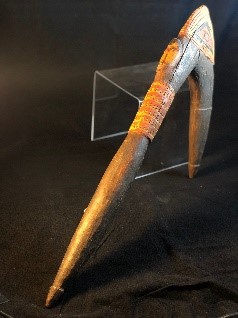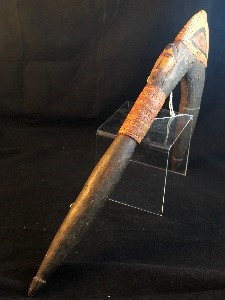The sago pounder is a tool used to harvest and process the inner bark of the sago palm, which provides a staple food for the people of the Sepik Region of New Guinea. For this process, the sago palm is first cut open and the bark is removed. Next, the sago pounder is used like an axe or hoe to gradually scrape the inner bark or pith from the outer bark. The pith is then cleaned, ground up, soaked, and made into a pudding.
Several features identify this sago pounder as the product of an Asmat artisan. First, Asmat pounders are carved from one piece of wood, while other Sepik pounders are made of multiple pieces of wood. The carved and painted triangular designs are also popular among the Asmat. The most telling feature, however, is the large notch on this sago pounder. This notch allowed the Asmat people to attach a sharpened rock known as a fiase. The fiase enables the sago pounder to cut more deeply into the bark and effectively remove more pith, and thus more food, from the palm.

Sago Pounder with Carved Face
Asmat culture
Early to mid-20th century
Wood and pigment
L. 27 cm x W. 5 cm x H. 64 cm
Drury collection #1971.1

Sago Pounder with Carved Face Asmat culture Early to mid-20th century Wood and pigment L. 27 cm x W. 5 cm x H. 64 cm Drury collection #1971.1
For more information, you may contact the researcher(s) noted in the title of this exhibit entry, or Dr. Billie Follensbee, the professor of the course, at BillieFollensbee@MissouriState.edu
